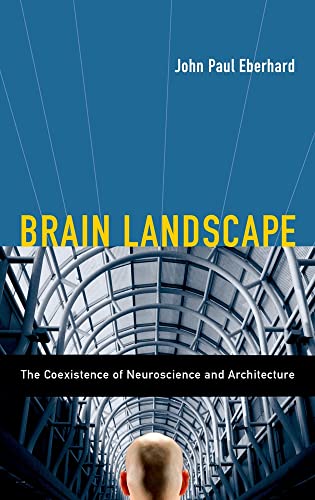Artículos relacionados a Brain Landscape The Coexistence of Neuroscience and...

Sinopsis
Brain Landscape: The Coexistence of Neuroscience and Architecture is the first book to serve as an intellectual bridge between architectural practice and neuroscience research. John P. Eberhard, founding President of the non-profit Academy of Neuroscience for Architecture, argues that increased funding, and the ability to think beyond the norm, will lead to a better understanding of how scientific research can change how we design, illuminate, and build spaces. Inversely, he posits that by better understanding the effects that buildings and places have on us, and our mental state, the better we may be able to understand how the human brain works. This book is devoted to describing architectural design criteria for schools, offices, laboratories, memorials, churches, and facilities for the aging, and then posing hypotheses about human experiences in such settings.
"Sinopsis" puede pertenecer a otra edición de este libro.
Acerca del autor
Charlotte y Peter Fiell son dos autoridades en historia, teoría y crítica del diseño y han escrito más de sesenta libros sobre la materia, muchos de los cuales se han convertido en éxitos de ventas. También han impartido conferencias y cursos como profesores invitados, han comisariado exposiciones y asesorado a fabricantes, museos, salas de subastas y grandes coleccionistas privados de todo el mundo. Los Fiell han escrito numerosos libros para TASCHEN, entre los que se incluyen 1000 Chairs, Diseño del siglo XX, El diseño industrial de la A a la Z, Scandinavian Design y Diseño del siglo XXI.
"Sobre este título" puede pertenecer a otra edición de este libro.
EUR 69,09 gastos de envío desde Reino Unido a España
Destinos, gastos y plazos de envíoComprar nuevo
Ver este artículoEUR 5,17 gastos de envío desde Reino Unido a España
Destinos, gastos y plazos de envíoResultados de la búsqueda para Brain Landscape The Coexistence of Neuroscience and...
Brain Landscape: The Coexistence of Neuroscience and Architecture
Librería: Ria Christie Collections, Uxbridge, Reino Unido
Condición: New. In. Nº de ref. del artículo: ria9780195331721_new
Cantidad disponible: Más de 20 disponibles
Brain Landscape
Librería: PBShop.store US, Wood Dale, IL, Estados Unidos de America
HRD. Condición: New. New Book. Shipped from UK. THIS BOOK IS PRINTED ON DEMAND. Established seller since 2000. Nº de ref. del artículo: L1-9780195331721
Cantidad disponible: Más de 20 disponibles
Brain Landscape
Librería: PBShop.store UK, Fairford, GLOS, Reino Unido
HRD. Condición: New. New Book. Delivered from our UK warehouse in 4 to 14 business days. THIS BOOK IS PRINTED ON DEMAND. Established seller since 2000. Nº de ref. del artículo: L1-9780195331721
Cantidad disponible: Más de 20 disponibles
Brain Landscape : The Coexistance of Neuroscience and Architecture
Librería: GreatBookPricesUK, Woodford Green, Reino Unido
Condición: New. Nº de ref. del artículo: 5971023-n
Cantidad disponible: Más de 20 disponibles
Brain Landscape the Coexistence of Neuroscience and Architecture
Librería: Buchpark, Maidenhead, Berkshire, Reino Unido
Condición: Fair. Condition: Fair | Pages: 280 | Language: English | Product Type: Books. Nº de ref. del artículo: 4601527/24
Cantidad disponible: 1 disponibles
Brain Landscape : The Coexistance of Neuroscience and Architecture
Librería: GreatBookPrices, Columbia, MD, Estados Unidos de America
Condición: New. Nº de ref. del artículo: 5971023-n
Cantidad disponible: Más de 20 disponibles
Brain Landscape : The Coexistance of Neuroscience and Architecture
Librería: GreatBookPrices, Columbia, MD, Estados Unidos de America
Condición: As New. Unread book in perfect condition. Nº de ref. del artículo: 5971023
Cantidad disponible: Más de 20 disponibles
Brain Landscape: The Coexistence of Neuroscience and Architecture
Librería: THE SAINT BOOKSTORE, Southport, Reino Unido
Hardback. Condición: New. This item is printed on demand. New copy - Usually dispatched within 5-9 working days 546. Nº de ref. del artículo: C9780195331721
Cantidad disponible: Más de 20 disponibles
Brain Landscape : The Coexistance of Neuroscience and Architecture
Librería: GreatBookPricesUK, Woodford Green, Reino Unido
Condición: As New. Unread book in perfect condition. Nº de ref. del artículo: 5971023
Cantidad disponible: Más de 20 disponibles
Brain Landscape (Hardcover)
Librería: CitiRetail, Stevenage, Reino Unido
Hardcover. Condición: new. Hardcover. Brain Landscape: The Coexistence of Neuroscience and Architecture is the first book to serve as an intellectual bridge between architectural practice and neuroscience research. John P. Eberhard, founding President of the non-profit Academy of Neuroscience for Architecture, argues that increased funding, and the ability to think beyond the norm, will lead to a better understanding of how scientific research can change how we design, illuminate, and buildspaces. Inversely, he posits that by better understanding the effects that buildings and places have on us, and our mental state, the better we may be able to understand how the human brain works. This book isdevoted to describing architectural design criteria for schools, offices, laboratories, memorials, churches, and facilities for the aging, and then posing hypotheses about human experiences in such settings. This book provides both neuroscientists and architects with methods of organizing research that would help us understand human experiences in architectural settings. Shipping may be from our UK warehouse or from our Australian or US warehouses, depending on stock availability. Nº de ref. del artículo: 9780195331721
Cantidad disponible: 1 disponibles
